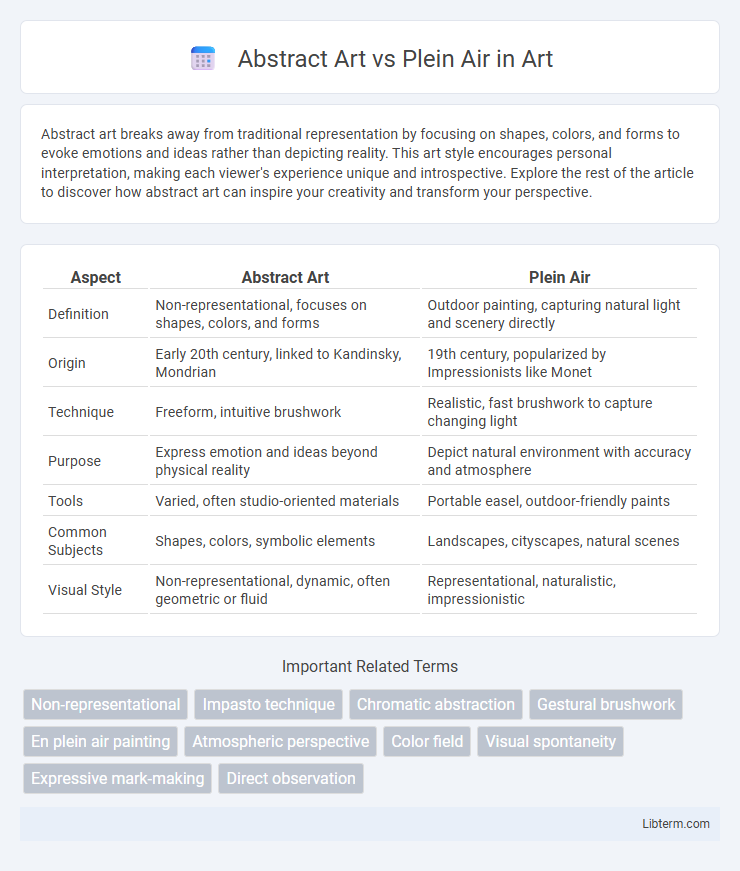Abstract art breaks away from traditional representation by focusing on shapes, colors, and forms to evoke emotions and ideas rather than depicting reality. This art style encourages personal interpretation, making each viewer's experience unique and introspective. Explore the rest of the article to discover how abstract art can inspire your creativity and transform your perspective.
Table of Comparison
| Aspect | Abstract Art | Plein Air |
|---|---|---|
| Definition | Non-representational, focuses on shapes, colors, and forms | Outdoor painting, capturing natural light and scenery directly |
| Origin | Early 20th century, linked to Kandinsky, Mondrian | 19th century, popularized by Impressionists like Monet |
| Technique | Freeform, intuitive brushwork | Realistic, fast brushwork to capture changing light |
| Purpose | Express emotion and ideas beyond physical reality | Depict natural environment with accuracy and atmosphere |
| Tools | Varied, often studio-oriented materials | Portable easel, outdoor-friendly paints |
| Common Subjects | Shapes, colors, symbolic elements | Landscapes, cityscapes, natural scenes |
| Visual Style | Non-representational, dynamic, often geometric or fluid | Representational, naturalistic, impressionistic |
Introduction to Abstract Art and Plein Air
Abstract Art emphasizes non-representational forms, using colors, shapes, and lines to evoke emotions rather than depicting realistic scenes. Plein Air painting involves creating artworks outdoors, capturing natural light and landscapes with immediate observation. Both approaches offer distinct artistic experiences, with Abstract Art focusing on inner expression and Plein Air on direct environmental interaction.
Historical Origins and Development
Abstract art emerged in the early 20th century as artists like Wassily Kandinsky and Piet Mondrian sought to express emotions and ideas through non-representational forms, breaking away from traditional realism. Plein air painting developed in the mid-19th century with the Barbizon School and Impressionists such as Claude Monet emphasizing outdoor, natural light to capture transient moments and atmospheric effects. While abstract art evolved through modernist movements focusing on conceptual interpretation, plein air painting maintained a dedication to observing and portraying the natural environment directly.
Key Philosophies and Artistic Principles
Abstract art emphasizes the expression of emotions and ideas through non-representational forms, prioritizing color, shape, and texture over realistic depiction. Plein air painting centers on capturing the natural light and atmosphere of outdoor scenes, adhering to direct observation and the transient qualities of the environment. The core artistic principle of abstract art lies in subjective interpretation, while plein air upholds objective representation of nature.
Techniques and Mediums Used
Abstract art employs techniques such as layering, dripping, and bold brushstrokes to convey emotions and ideas through non-representational forms, often utilizing acrylics, oils, and mixed media on canvas or paper. Plein air painting emphasizes capturing natural light and atmosphere directly from outdoor scenes, primarily using oil or watercolor paints applied swiftly to reflect changing environmental conditions. Both styles demand distinct approaches: abstract art prioritizes internal expression and experimentation with textures, while plein air relies on realistic observation and rapid execution.
Capturing Emotion vs. Capturing Environment
Abstract art prioritizes capturing emotion through non-representational forms, colors, and textures that evoke feelings and inner experiences. Plein air painting emphasizes capturing the environment by depicting natural light, atmospheric conditions, and realistic landscapes directly from observation. The contrast lies in abstract art's focus on emotional expression versus plein air's dedication to accurate environmental representation.
Influence of Light and Color
Abstract art emphasizes the emotional and conceptual use of color and light, often distorting or exaggerating natural hues to evoke mood and meaning. Plein air painting captures the natural light and atmosphere directly from the outdoor environment, relying on the accurate representation of changing daylight and shadows to enhance realism. The influence of light in plein air is transient and specific, while abstract art uses color and light more flexibly to express subjective interpretations beyond realistic depiction.
Role of Imagination vs. Observation
Abstract art prioritizes the role of imagination, allowing artists to express emotions, concepts, and ideas beyond literal representation. Plein air painting emphasizes direct observation of natural light, color, and atmosphere, capturing the environment in real time. The contrast lies in abstract art's internal creativity versus plein air's external visual accuracy.
Notable Artists and Iconic Works
Abstract art features notable artists such as Wassily Kandinsky, whose work "Composition VII" exemplifies dynamic forms and vibrant colors. Plein air painting includes iconic figures like Claude Monet, renowned for his "Impression, Sunrise," which captures natural light and atmosphere. Both movements emphasize distinct approaches to expression: abstraction through non-representational forms and plein air through direct observation of the environment.
Impact on Modern Art Movements
Abstract art revolutionized modern art movements by emphasizing emotional expression and non-representational forms, influencing Cubism, Expressionism, and Minimalism. Plein air painting, rooted in natural light and outdoor techniques, shaped Impressionism and Realism, encouraging direct observation and spontaneity. Both approaches challenged traditional academic standards, fostering diverse explorations in color, form, and perception that continue to inspire contemporary art practices.
Contemporary Perspectives and Future Trends
Contemporary perspectives on Abstract Art emphasize emotional expression and innovative use of form and color, while Plein Air continues to prioritize direct engagement with natural light and environment. Future trends indicate a convergence where digital technology enhances traditional Plein Air techniques and Abstract Art incorporates virtual reality to create immersive experiences. Both movements evolve by integrating sustainability practices and expanding global cultural influences.
Abstract Art Infographic

 libterm.com
libterm.com